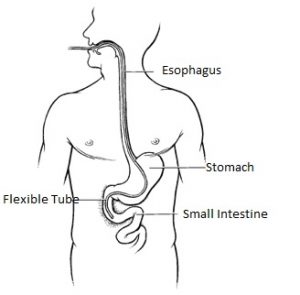Endoscopic Ultrasound
The following information explains what typically happens during and after an endoscopic ultrasound. If you have questions or concerns about the test or the information in this material, talk to a member of your health care team.
Purpose of the procedure
The purpose of an endoscopic ultrasound is to view organs that are adjacent to the stomach and intestines, such as the liver, pancreas, gall bladder and bile ducts, and to view the intestinal wall (Figure 1).
The endoscope is equipped with a miniature camera that transmits a picture to a video screen. There is also an open channel in the endoscope through which the physician may pass instruments to:
- Obtain biopsy specimens (tissue samples) or perform treatment
- Remove foreign objects or polyps
- Stop intestinal bleeding
- Inject solutions

An ultrasound probe, located at the tip of the endoscope, makes it possible to view internal organs and structures that are located outside of the gastrointestinal tract. A computer transforms the ultrasound waves into a moving image on a video screen.
During the procedure
You may receive medication through a vein, called intravenous (IV) sedation, to help you relax and make you more comfortable. It may make you sleepy.
An anesthetic may be sprayed into your throat to numb it. The physician puts an endoscope into your mouth. The tube does not interfere with breathing. You are monitored throughout the procedure.
It may be necessary to gently stretch (dilate) the esophagus with a tube to help with the passage of the endoscope. You may have a feeling of pressure or fullness as the endoscope is moved or as air is inserted through the tube. The air may cause you to belch.
After the procedure
When your examination is finished, you are taken to the recovery area where you will be monitored.
- Effects of sedation: As a result of the sedation you receive, you may have lapses of memory, slowed reaction time, and impaired judgment for 24 hours. For your safety and the safety of others, do not drive for 24 hours after the procedure. Do not assume responsibility for young children or anyone dependent on your care.
Avoid making important decisions or signing legal documents. Have a responsible adult stay with you for the remainder of the day. - Discomfort: You may have a mild sore throat. Throat lozenges and a non-aspirin pain reliever containing acetaminophen, such as Tylenol™ or generic equivalent, in the recommended dose as needed may help soothe your throat. Blood-tinged saliva for a short time after your examination is normal. Do not be alarmed by this.
It is normal to feel bloated, have gas pains and pass large amounts of air after your examination until the air is expelled from your gastrointestinal tract, usually the day of your examination. Walking may help relieve discomfort. - Medications: You may resume taking your medications unless otherwise instructed by your health care provider. If you have diabetes or take blood thinners and are unsure about when to resume taking your medications, talk with your health care provider.
- Activity: Rest for the remainder of the day. When you feel you are able, resume your regular activity level, unless instructed otherwise by your health care provider.
- Diet: Resume your regular diet when you feel able to do so unless you are scheduled for additional tests that require a special diet. If you had esophageal dilatation, start with clear liquids and soft foods. Add solid foods when you are able to comfortably eat them and following the advice of your health care provider. Do not drink alcoholic beverages for 24 hours.
- Test results: Talk with your health care provider who ordered the test about how to get your procedure results.
Possible risks
Ultrasound exposure does not involve the use of X-rays or radiation. There are no known risks associated with ultrasound exposure.
Serious complications with endoscopy procedures are rare. Bleeding, especially after dilatation or removal of a polyp, is one possible complication. A perforation or tear in the lining of the esophagus or gastrointestinal tract may occur. Both of these complications usually require hospitalization and, possibly, surgery. Infection also is associated with endoscopy procedures.
Occasionally, a pancreas biopsy is taken using endoscopic ultrasound. In these cases, a small number of people (less than one percent) may develop inflammation of the pancreas (pancreatitis). This usually causes abdominal pain within several hours of the procedure. Pancreatitis may require hospitalization.
In advance of the procedure, discuss possible risks and complications with your health care provider.
When to seek medical help
Seek emergency medical care if you experience any of the following:
- Vomit blood
- Pass black or very dark stools
- Neck or chest pain
- Continuous abdominal pain that is not relieved by expelling gas, and/or.
- Develop a temperature of 100.4 degrees Fahrenheit (38 degrees Celsius) or greater.
If you have any questions about your endoscopic ultrasound or the examination itself, talk with your Mayo Clinic health care provider.

